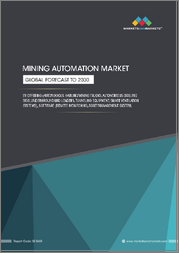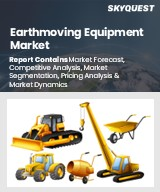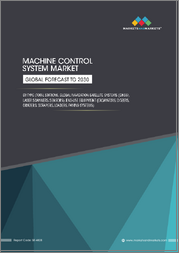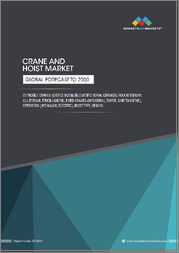
|
시장보고서
상품코드
1809849
컴팩트 다관절 로더 시장 : 엔진 유형별, 유형별, 엔진 파워별, 리프팅 능력별, 최종사용자별, 판매 채널별 - 세계 예측(2025-2030년)Compact Articulated Loader Market by Engine Type, Type, Engine Power, Lifting Capacity, End-User, Sales Channel - Global Forecast 2025-2030 |
||||||
컴팩트 다관절 로더 시장의 2024년 시장 규모는 16억 8,000만 달러로 평가되었으며, 2025년에는 17억 7,000만 달러, CAGR 5.65%로 성장하여 2030년에는 23억 3,000만 달러에 달할 것으로 예측됩니다.
| 주요 시장 통계 | |
|---|---|
| 기준 연도 2024년 | 16억 8,000만 달러 |
| 추정 연도 2025년 | 17억 7,000만 달러 |
| 예측 연도 2030년 | 23억 3,000만 달러 |
| CAGR(%) | 5.65% |
컴팩트 다관절 로더의 새로운 상황과 건설, 농업 및 산업 응용 분야에 미치는 영향에 대한 정의
컴팩트 다관절 로더는 다양한 성능, 뛰어난 기동성, 콤팩트한 설치 공간으로 인해 건설 현장, 농지, 산업 시설에서 없어서는 안 될 자산으로 부상하고 있습니다. 독특한 결합 섀시 설계가 특징인 이 기계는 좁은 공간에서 정밀한 작동을 가능하게 하는 좁은 회전 반경을 제공합니다. 전 세계적으로 인프라 프로젝트가 강화되고 도시 개발이 가속화됨에 따라 좁은 골목길을 통과하고, 다층 구조물에서 작업하고, 열악한 환경에서 작동하는 장비에 대한 수요가 크게 증가하고 있습니다.
지속가능성, 자동화 및 진화하는 산업 요구 사항을 통해 컴팩트 아티큘레이티드 로더의 운영을 변화시키는 혁신적 변화를 탐색합니다.
지난 몇 년 동안 소형 굴착기 업계는 지속가능성 의무화, 디지털 통합, 사용자 기대치의 진화로 인해 큰 변화를 겪어왔습니다. 이해관계자들은 탄소배출량 감축에 점점 더 중점을 두고 있으며, 대체 에너지원과 전기 파워트레인에 대한 관심이 가속화되고 있습니다. 이와 함께 배출가스 저감 및 소음 감소를 촉진하는 규제 프레임워크는 협력업체들이 첨단 엔진 아키텍처와 배터리 솔루션을 모색하도록 유도하고 있습니다.
2025년 미국 관세가 컴팩트 로더 제조업체의 공급망, 비용 구조, 전략적 조달에 미치는 누적적 영향 파악
2025년 철강, 알루미늄, 일부 기계 부품에 대한 새로운 관세 부과로 인해 컴팩트 다관절 로더 제조업체의 공급망 전체에 새로운 복잡성이 발생했습니다. 수입 원자재에 대한 관세 인상은 많은 OEM들이 공급처를 다변화하고 비용 변동에 대비하기 위해 국내 제휴를 모색하는 등 조달 전략을 재조정하는 결과를 가져왔습니다. 이러한 조정은 재고 관리, 리드 타임, 생산 일정에도 영향을 미치며, 조달, 운영, 물류 팀 간의 조정을 강화해야 합니다.
엔진 기술, 섀시 설계, 정격 출력, 리프팅 능력, 최종사용자 용도, 판매 채널에 대한 주요 세분화 인사이트 공개
컴팩트 굴착기의 엔진 유형은 성능 최적화 및 환경 규제 준수에 있어 매우 중요한 역할을 합니다. 디젤 엔진 구동 유닛은 장시간 운전과 높은 토크 출력을 필요로 하는 응용 분야에서 여전히 우위를 점하고 있으며, 전기 구동 방식은 소음에 민감하고 배기가스 규제가 있는 환경에서 인기를 얻고 있습니다. 하이브리드 구성은 기존 연료 시스템과 완전 전기화 사이의 가교 역할을 하고 있으며, 동력 공급에 대한 타협 없이 연료 소비를 줄일 수 있는 대안으로 떠오르고 있습니다.
아메리카, 유럽, 중동 및 아프리카, 아시아태평양의 컴팩트 다관절 로더 시장에서 중요한 지역 역학 및 전략적 포지셔닝을 검토합니다.
소형 굴착기 분야의 지역 역학은 다양한 수준의 인프라 확장, 규제 프레임워크, 산업 활동에 의해 형성되고 있습니다. 아메리카에서는 도시 재개발과 지속가능한 농업에 대한 지속적인 노력으로 인해 첨단 배기가스 제어 및 텔레매틱스 기능이 통합된 기계에 대한 수요가 증가하고 있습니다. 북미의 경제적 안정은 함대 업그레이드를 촉진하고, 남미의 신흥 경제는 비용 효율적인 다목적 장비의 기회를 제공합니다.
컴팩트 다관절 로더 분야의 주요 제조업체 및 신규 진입업체들의 주요 전략적 움직임과 혁신의 원동력을 살펴봅니다.
주요 제조업체들은 전략적 제휴, 인수, 그리고 타겟팅된 기술 혁신을 통해 컴팩트 다관절 로더 분야에서 입지를 강화하고 있습니다. 레거시 OEM은 첨단 텔레매틱스 플랫폼, 원격 진단 및 차량 관리 도구를 통합하기 위해 기술 제공업체와 합작회사를 설립하고 있습니다. 동시에 배터리 및 전기 파워트레인 전문가와의 제휴를 통해 강화된 규제 의무를 준수하는 무공해 모델 개발을 가속화할 수 있습니다.
업계 리더가 신기술을 활용하고 경쟁 우위를 유지하며 경영 효율을 최적화하기 위한 실행 가능한 전략
업계 리더들은 진화하는 환경 규제를 준수하고 최종사용자의 지속가능성 목표를 달성하기 위해 전동화 파워트레인과 첨단 배기가스 제어 기술을 통합하는 것을 우선시해야 합니다. R&D 투자를 지역 정책적 인센티브와 연계함으로써, 기업은 제품 도입을 가속화하고 저배출 솔루션을 찾는 얼리 어답터들을 끌어들일 수 있습니다.
컴팩트 다관절 로더 산업에 대한 종합적인 분석을 뒷받침하는 엄격한 조사 방법론에 대한 해명.
이 분석은 산업을 포괄적으로 다루기 위해 1차 조사와 2차 검증을 결합한 견고한 조사 방법을 기반으로 합니다. C레벨 경영진, 제품 관리자, 최종사용자 대표를 대상으로 광범위한 인터뷰를 실시하여 비즈니스 과제, 기술 채택 동향, 전략적 우선순위에 대한 생생한 관점을 파악했습니다. 또한, 조달 프로세스, 애프터 세일즈 요구사항, 법규 준수에 대한 심층 조사를 통해 정성적 평가를 실시하였습니다.
로더 장비 부문의 의사결정에 정보를 제공하고 향후 이니셔티브를 안내하기 위한 주요 발견과 시사점을 통합합니다.
주요 조사 결과를 종합하면 몇 가지 종합적인 주제가 나타났습니다. 전기화 및 배출가스 관리로의 가속화된 전환, 장비 가동시간 향상에 있어 디지털 서비스의 중요성 증대, 그리고 무역 정책의 영향에 대한 전략적 탐색이 그것입니다. 이러한 역학관계는 로더 장비 부문의 제품 개발 로드맵, 운영 전략, 고객 참여 모델에 큰 영향을 미치고 있습니다.
목차
제1장 서문
제2장 조사 방법
제3장 주요 요약
제4장 시장 개요
제5장 시장 역학
제6장 시장 인사이트
- Porter's Five Forces 분석
- PESTEL 분석
제7장 미국 관세의 누적 영향 2025
제8장 컴팩트 다관절 로더 시장 : 엔진 유형별
- 디젤 엔진
- 전동
- 하이브리드
제9장 컴팩트 다관절 로더 시장 : 유형별
- 트럭 기반
- 휠 베이스
제10장 컴팩트 다관절 로더 시장 : 엔진 파워별
- 25-50 마력
- 50HP 이상
- 25 HP 이하
제11장 컴팩트 다관절 로더 시장 : 양력별
- 1,000-2,000 파운드
- 2,000 파운드 이상
- 최대 1,000 파운드
제12장 컴팩트 다관절 로더 시장 : 최종사용자별
- 농업
- 건설·인프라
- 상업 프로젝트
- 주택 프로젝트
- 도시 인프라
- 임업
- 사이트 정지
- 목재 취급
- 산업·창고
- 적재/하역
- 자재관리
- 팔레트 운송
- 광업과 채석업
- 시정 서비스
- 공원 및 레크리에이션 에어리어 유지보수
- 도로변 유지보수와 수리
- 제설
제13장 컴팩트 다관절 로더 시장 : 판매 채널별
- 오프라인
- 온라인
제14장 아메리카의 컴팩트 다관절 로더 시장
- 미국
- 캐나다
- 멕시코
- 브라질
- 아르헨티나
제15장 유럽, 중동 및 아프리카의 컴팩트 다관절 로더 시장
- 영국
- 독일
- 프랑스
- 러시아
- 이탈리아
- 스페인
- 아랍에미리트
- 사우디아라비아
- 남아프리카공화국
- 덴마크
- 네덜란드
- 카타르
- 핀란드
- 스웨덴
- 나이지리아
- 이집트
- 튀르키예
- 이스라엘
- 노르웨이
- 폴란드
- 스위스
제16장 아시아태평양의 컴팩트 다관절 로더 시장
- 중국
- 인도
- 일본
- 호주
- 한국
- 인도네시아
- 태국
- 필리핀
- 말레이시아
- 싱가포르
- 베트남
- 대만
제17장 경쟁 구도
- 시장 점유율 분석, 2024
- FPNV 포지셔닝 매트릭스, 2024
- 경쟁 분석
- Avant Tecno Oy
- Bobcat Company
- Cast Group S.R.L.
- Caterpillar Inc.
- CNH Industrial N.V.
- Deere & Company
- Hitachi Construction Machinery Co., Ltd.
- J C Bamford Excavators Ltd.
- Komatsu Europe International N.V.
- KUBOTA Corporation
- Liebherr Group
- Manitou Group
- MECALAC France SAS by Fayat Group
- MultiOne S.r.l.
- Alamo Group Inc.
- Schaffer Maschinenfabrik GmbH
- SHERPA mini-loaders B.V.
- Takeuchi Mfg. Co. Ltd.
- Tobroco-Giant
- Vermeer Corporation
- Volvo Group
- Wacker Neuson Group
- XCMG Group
- Yanmar Holdings Co., Ltd.
- YUFAN Machinery
제18장 리서치 AI
제19장 리서치 통계
제20장 리서치 컨택트
제21장 리서치 기사
제22장 부록
KSM 25.09.18The Compact Articulated Loader Market was valued at USD 1.68 billion in 2024 and is projected to grow to USD 1.77 billion in 2025, with a CAGR of 5.65%, reaching USD 2.33 billion by 2030.
| KEY MARKET STATISTICS | |
|---|---|
| Base Year [2024] | USD 1.68 billion |
| Estimated Year [2025] | USD 1.77 billion |
| Forecast Year [2030] | USD 2.33 billion |
| CAGR (%) | 5.65% |
Defining the Emerging Landscape of Compact Articulated Loaders and Their Impact Across Construction, Agriculture, and Industrial Applications
Compact articulated loaders have emerged as indispensable assets across construction sites, agricultural fields, and industrial facilities due to their versatile performance, superior maneuverability, and compact footprint. Characterized by their unique jointed chassis design, these machines deliver a tight turning radius that enables precise operation in confined spaces. As global infrastructure projects intensify and urban development accelerates, the demand for equipment that can navigate narrow alleys, work within multi-story structures, and function in demanding environments has grown significantly.
Beyond construction and urban applications, compact articulated loaders have found new avenues in agricultural mechanization, forestry site clearing, and materials handling in warehousing environments. Their ability to switch attachments rapidly-from buckets and forks to augers and grapples-enhances operational flexibility, reduces downtime, and improves return on equipment investment. Consequently, enterprises seeking to optimize labor efficiency and reduce lifecycle operating costs are increasingly integrating these machines into their fleets.
This executive summary provides a concise overview of the transformative forces, regulatory influences, segmentation dynamics, regional differentials, competitive landscapes, and actionable recommendations shaping the compact articulated loader sector today. By synthesizing qualitative insights from industry experts and secondary research, it equips stakeholders with a clear understanding of critical trends and strategic imperatives, setting the stage for more detailed examination in subsequent sections.
Navigating the Transformative Shifts Reshaping Compact Articulated Loader Operations Through Sustainability, Automation, and Evolving Industry Demands
Over the past few years, the compact articulated loader industry has undergone profound shifts driven by sustainability mandates, digital integration, and evolving user expectations. Stakeholders are increasingly focused on reducing carbon footprints, which has accelerated interest in alternative energy sources and electrified powertrains. In parallel, regulatory frameworks promoting emissions reduction and noise abatement have prompted original equipment manufacturers to explore advanced engine architectures and battery solutions.
Simultaneously, the integration of telematics, remote diagnostics, and predictive maintenance platforms has reshaped product offerings. Buyers now expect real-time performance monitoring, automated alerts, and data-driven insights that streamline service schedules and minimize unplanned downtime. As a result, OEMs are forging partnerships with technology providers and software developers to deliver ecosystems that enhance asset utilization and lifecycle management.
Moreover, a new breed of end users-ranging from small-scale contractors to large municipal agencies-is demanding machines that balance performance with cost efficiency. This convergence of environmental responsibility, digital transformation, and diverse application requirements underscores the industry's pivot toward smarter, greener, and more adaptable equipment. In light of these transformative trends, suppliers and end users alike must recalibrate their strategies to harness emerging opportunities and mitigate operational risks.
Unpacking the Cumulative Impact of United States Tariffs in 2025 on Supply Chains, Cost Structures, and Strategic Procurement for Compact Loader Manufacturers
In 2025, newly imposed tariffs on steel, aluminum, and select mechanical components have introduced fresh complexities across supply chains for manufacturers of compact articulated loaders. The increased duties on imported raw materials have led to recalibrated procurement strategies, with many OEMs diversifying supplier bases and exploring domestic partnerships to shield themselves from cost volatility. These adjustments have in turn influenced inventory management, lead times, and production schedules, necessitating enhanced coordination across procurement, operations, and logistics teams.
Concurrently, aftermarket providers and parts distributors are reconfiguring their networks to ensure timely availability of critical spares and minimize service disruptions. Repair centers are investing in buffer inventory and local sourcing agreements to guarantee continuity of maintenance services for end users. As a direct consequence, maintenance costs for certain loader models have shifted, prompting operators to reassess total cost of ownership and explore alternative service contracts.
Looking ahead, companies are proactively exploring tariff mitigation strategies such as tariff engineering, bilateral sourcing agreements, and collaborative demand aggregation with industry consortia. By adopting flexible sourcing policies and dynamically adjusting bill of materials, manufacturers aim to sustain competitive pricing and safeguard operational resilience in the face of evolving trade policies.
Revealing Key Segmentation Insights in Engine Technologies, Chassis Designs, Power Ratings, Lifting Capacities, End-User Applications, and Sales Channels
The engine type of compact articulated loaders plays a pivotal role in performance optimization and environmental compliance. Diesel-powered units continue to dominate applications requiring extended run times and high torque outputs, while electric-powered variants gain traction in noise-sensitive and emissions-regulated environments. Hybrid configurations are emerging as a bridge between conventional fuel systems and full electrification, delivering reduced fuel consumption without compromising on power delivery.
Chassis preference further delineates user requirements, with track-based models offering superior ground stability and flotation in soft terrain or uneven work sites, and wheel-based variants prized for faster travel speeds and smoother operation on paved surfaces. This dichotomy underscores the importance of aligning machine mobility characteristics with specific jobsite conditions.
Engine power ratings are another lens through which operators assess suitability. Units within the 25-50 HP range are favored for light-to-medium tasks that demand agility combined with sufficient lifting force. Machines above 50 HP cater to heavy-duty assignments where elevated horsepower translates into faster cycle times and enhanced productivity. Meanwhile, sub-25 HP compact units enable cost-effective performance for precise indoor and landscaping operations.
Lifting capacity segmentation highlights the need for machines capable of handling payloads up to 1,000 lbs for small-scale material transfers, 1,000-2,000 lbs for mid-range loading and stockpiling, and above 2,000 lbs for rigorous loading, high-density tasks, and extended reach requirements. Matching lift capability with application demands ensures optimal safety margins and operational efficiency.
End users span a diverse spectrum, from agriculture and construction & infrastructure to forestry, industrial & warehousing, mining & quarrying, and municipal services. Within construction & infrastructure, applications range from commercial and residential projects to urban infrastructure maintenance. Forestry deployment encompasses site clearing and timber handling, while industrial and warehousing activities include loading/unloading, material handling, and pallet transport. Municipal services leverage loaders for park and recreational area maintenance, roadside repairs, and seasonal snow removal.
Sales channel dynamics split between traditional offline dealerships providing hands-on demos and servicing expertise, and online platforms that streamline acquisition for digital-savvy buyers. Recognizing these varied segmentation layers enables stakeholders to tailor product roadmaps, pricing strategies, and customer support models to distinct end-use scenarios.
Examining Critical Regional Dynamics in the Compact Articulated Loader Market Across the Americas, EMEA, and Asia-Pacific for Strategic Positioning
Regional dynamics in the compact articulated loader sector are shaped by varying levels of infrastructure expansion, regulatory frameworks, and industrial activity. In the Americas, the continued rollout of urban redevelopment and sustainable agriculture initiatives drives demand for machines integrating advanced emissions control and telematics features. Economic stability in North America fosters fleet upgrades, while emerging economies in South America present opportunities for cost-effective, multi-purpose equipment.
Europe, Middle East & Africa (EMEA) is characterized by stringent emissions regulations and a strong push toward electrification, particularly in Western Europe. Governments incentivize low-emission equipment in urban centers and protected environmental zones, prompting suppliers to prioritize electric-powered models and hybrid prototypes. In contrast, infrastructure development in the Middle East and Africa fuels demand for high-torque, diesel-powered units equipped for harsh terrain and temperature extremes.
Asia-Pacific remains a dynamic theater, where rapid industrialization, large-scale infrastructure programs, and agricultural modernization converge. China's focus on clean energy has accelerated the introduction of electric and hybrid loaders, while Southeast Asia's construction boom sustains robust demand for versatile, cost-effective machines. In Australia and New Zealand, the forestry and mining sectors continue to rely on durable, agile loaders capable of handling demanding site conditions.
These regional distinctions, influenced by regulatory landscapes, terrain challenges, and sectoral growth patterns, underscore the importance of customizing product offerings and service models to local market nuances and operational requirements.
Distilling Key Strategic Moves and Innovation Drivers from Leading Manufacturers and New Entrants in the Compact Articulated Loader Space
Leading manufacturers are leveraging strategic alliances, acquisitions, and targeted innovation to strengthen their foothold in the compact articulated loader arena. Legacy OEMs are forming joint ventures with technology providers to integrate advanced telematics platforms, remote diagnostics, and fleet management tools. At the same time, partnerships with battery and electric powertrain specialists enable accelerated development of zero-emission models that comply with tightening regulatory mandates.
New entrants and niche players are carving out presence by specializing in custom attachment systems, rapid tool change mechanisms, and modular platform architectures that enhance machine versatility. These upstarts often adopt agile development cycles and digital prototyping to bring unique solutions to market more rapidly than traditional competitors.
Collaborations between manufacturers and aftermarket service chains are redefining parts availability and support networks. By co-investing in spare parts hubs and mobile service units, industry players aim to reduce maintenance downtime and extend equipment lifecycles. Furthermore, recent patent filings and R&D investments reveal a focus on noise-reduction technologies, automated leveling systems, and operator assistance features designed to elevate safety and productivity.
Collectively, these strategic moves and innovation trajectories are reshaping competitive dynamics, driving a greater emphasis on software-enabled services, flexible platform design, and sustainability-led product differentiation.
Actionable Strategies for Industry Leaders to Capitalize on Emerging Technologies, Sustain Competitive Advantage, and Optimize Operational Efficiencies
Industry leaders should prioritize the integration of electrified powertrains and advanced emissions control technologies to comply with evolving environmental regulations and meet end-user sustainability objectives. By aligning R&D investments with regional policy incentives, companies can accelerate product introductions and capture early adopters seeking low-emission solutions.
Furthermore, forging deeper partnerships with telematics and analytics providers will enable OEMs and dealers to deliver predictive maintenance, utilization dashboards, and remote support capabilities. Such collaborations not only enhance customer experience but also create recurring revenue streams through data-driven service offerings.
To address tariff-related challenges, stakeholders should pursue diversified sourcing strategies and regional manufacturing footprints. Establishing component assembly lines in multiple trade zones can mitigate cost fluctuations and ensure uninterrupted production. Parallel efforts in tariff engineering and bill of materials optimization will further shield organizations from duty increases.
Customizing sales and service models to specific end-use segments-whether agricultural operations, commercial construction, or municipal services-will drive deeper market penetration. Tailoring financing options, equipment bundles, and aftermarket agreements to unique operational needs fosters long-term relationships and brand loyalty.
Lastly, investing in operator training programs and augmented reality tools will enhance machine performance, safety, and productivity on job sites. Equipping customers with digital learning resources and immersive diagnostics platforms strengthens service ecosystems and reinforces competitive differentiation.
Illuminating the Rigorous Research Methodology Underpinning the Comprehensive Analysis of the Compact Articulated Loader Industry
This analysis is grounded in a robust methodology that combines primary research and secondary validation to ensure comprehensive industry coverage. Extensive interviews were conducted with C-level executives, product managers, and end-user representatives to capture firsthand perspectives on operational challenges, technology adoption trends, and strategic priorities. Detailed inquiries into procurement processes, aftersales requirements, and regulatory compliance informed the qualitative evaluation.
Secondary research involved a systematic review of technical white papers, industry association guidelines, and regulatory publications. Company filings, patent databases, and trade journals provided additional context on innovation trajectories, competitive developments, and global trade policies. These findings were triangulated to validate insights and ensure consistency across multiple data sources.
Analytical frameworks were applied to dissect segmentation layers, regional differentials, and competitive positioning. Each insight was cross-checked against operational case studies and real-world deployment scenarios to confirm practical relevance. This multi-stage research design ensures that the conclusions and recommendations presented herein reflect both strategic imperatives and ground-level realities.
Synthesizing Core Findings and Implications to Inform Decision-Making and Guide Future Initiatives in the Loader Equipment Sector
In synthesizing the key findings, several overarching themes emerge: the accelerating shift toward electrification and emissions management, the growing importance of digital services in enhancing equipment uptime, and the strategic navigation of trade policy impacts. Each of these dynamics exerts profound influence on product development roadmaps, operational strategies, and customer engagement models within the loader equipment sector.
As regional market nuances continue to shape demand profiles-from the infrastructure-led expansion in the Americas to the electrification drive in Europe and the rapid industrial growth in Asia-Pacific-suppliers must remain agile in adapting their offerings. The competitive landscape will increasingly reward organizations that integrate sustainability, connectivity, and adaptability into holistic value propositions.
These insights underscore the imperative for stakeholders to balance technological innovation with pragmatic considerations around supply chain resilience and localized support capabilities. In doing so, they can position themselves to capture emerging opportunities, mitigate evolving risks, and sustain long-term growth in the dynamic compact articulated loader domain.
Table of Contents
1. Preface
- 1.1. Objectives of the Study
- 1.2. Market Segmentation & Coverage
- 1.3. Years Considered for the Study
- 1.4. Currency & Pricing
- 1.5. Language
- 1.6. Stakeholders
2. Research Methodology
- 2.1. Define: Research Objective
- 2.2. Determine: Research Design
- 2.3. Prepare: Research Instrument
- 2.4. Collect: Data Source
- 2.5. Analyze: Data Interpretation
- 2.6. Formulate: Data Verification
- 2.7. Publish: Research Report
- 2.8. Repeat: Report Update
3. Executive Summary
4. Market Overview
- 4.1. Introduction
- 4.2. Market Sizing & Forecasting
5. Market Dynamics
- 5.1. Increasing use of compact articulated loaders in agriculture and landscaping applications
- 5.2. Integration of advanced telematics systems for real-time loader performance monitoring
- 5.3. Increasing adoption of electric compact articulated loaders for eco-friendly construction operatons
- 5.4. Development of robust after-sales service and maintenance networks for loader longevity
- 5.5. Focus on fuel efficiency improvements to reduce operational costs in loader equipment
- 5.6. Rising demand for compact articulated loaders in urban infrastructure development projects
- 5.7. Growth of rental services as a preferred procurement model for compact articulated loaders
- 5.8. Enhancement of operator comfort and safety features in compact articulated loaders
- 5.9. Collaborations between manufacturers and dealers to improve after-sales service and parts availability
- 5.10. Implementation of automation and semi-autonomous technology in compact articulated loaders
6. Market Insights
- 6.1. Porter's Five Forces Analysis
- 6.2. PESTLE Analysis
7. Cumulative Impact of United States Tariffs 2025
8. Compact Articulated Loader Market, by Engine Type
- 8.1. Introduction
- 8.2. Diesel-Powered
- 8.3. Electric-Powered
- 8.4. Hybrid
9. Compact Articulated Loader Market, by Type
- 9.1. Introduction
- 9.2. Track Based
- 9.3. Wheel Based
10. Compact Articulated Loader Market, by Engine Power
- 10.1. Introduction
- 10.2. 25-50 HP
- 10.3. Above 50 HP
- 10.4. Below 25 HP
11. Compact Articulated Loader Market, by Lifting Capacity
- 11.1. Introduction
- 11.2. 1,000-2,000 lbs
- 11.3. Above 2,000 lbs
- 11.4. Up to 1,000 lbs
12. Compact Articulated Loader Market, by End-User
- 12.1. Introduction
- 12.2. Agriculture
- 12.3. Construction & Infrastructure
- 12.3.1. Commercial Projects
- 12.3.2. Residential Projects
- 12.3.3. Urban Infrastructure
- 12.4. Forestry
- 12.4.1. Site Clearing
- 12.4.2. Timber Handling
- 12.5. Industrial & Warehousing
- 12.5.1. Loading/Unloading
- 12.5.2. Material handling
- 12.5.3. Pallet Transport
- 12.6. Mining & Quarrying
- 12.7. Municipal Services
- 12.7.1. Park & Recreational Area Maintenance
- 12.7.2. Roadside Maintenance & Repairs
- 12.7.3. Snow Removal
13. Compact Articulated Loader Market, by Sales Channel
- 13.1. Introduction
- 13.2. Offline
- 13.3. Online
14. Americas Compact Articulated Loader Market
- 14.1. Introduction
- 14.2. United States
- 14.3. Canada
- 14.4. Mexico
- 14.5. Brazil
- 14.6. Argentina
15. Europe, Middle East & Africa Compact Articulated Loader Market
- 15.1. Introduction
- 15.2. United Kingdom
- 15.3. Germany
- 15.4. France
- 15.5. Russia
- 15.6. Italy
- 15.7. Spain
- 15.8. United Arab Emirates
- 15.9. Saudi Arabia
- 15.10. South Africa
- 15.11. Denmark
- 15.12. Netherlands
- 15.13. Qatar
- 15.14. Finland
- 15.15. Sweden
- 15.16. Nigeria
- 15.17. Egypt
- 15.18. Turkey
- 15.19. Israel
- 15.20. Norway
- 15.21. Poland
- 15.22. Switzerland
16. Asia-Pacific Compact Articulated Loader Market
- 16.1. Introduction
- 16.2. China
- 16.3. India
- 16.4. Japan
- 16.5. Australia
- 16.6. South Korea
- 16.7. Indonesia
- 16.8. Thailand
- 16.9. Philippines
- 16.10. Malaysia
- 16.11. Singapore
- 16.12. Vietnam
- 16.13. Taiwan
17. Competitive Landscape
- 17.1. Market Share Analysis, 2024
- 17.2. FPNV Positioning Matrix, 2024
- 17.3. Competitive Analysis
- 17.3.1. Avant Tecno Oy
- 17.3.2. Bobcat Company
- 17.3.3. Cast Group S.R.L.
- 17.3.4. Caterpillar Inc.
- 17.3.5. CNH Industrial N.V.
- 17.3.6. Deere & Company
- 17.3.7. Hitachi Construction Machinery Co., Ltd.
- 17.3.8. J C Bamford Excavators Ltd.
- 17.3.9. Komatsu Europe International N.V.
- 17.3.10. KUBOTA Corporation
- 17.3.11. Liebherr Group
- 17.3.12. Manitou Group
- 17.3.13. MECALAC France SAS by Fayat Group
- 17.3.14. MultiOne S.r.l.
- 17.3.15. Alamo Group Inc.
- 17.3.16. Schaffer Maschinenfabrik GmbH
- 17.3.17. SHERPA mini-loaders B.V.
- 17.3.18. Takeuchi Mfg. Co. Ltd.
- 17.3.19. Tobroco-Giant
- 17.3.20. Vermeer Corporation
- 17.3.21. Volvo Group
- 17.3.22. Wacker Neuson Group
- 17.3.23. XCMG Group
- 17.3.24. Yanmar Holdings Co., Ltd.
- 17.3.25. YUFAN Machinery



















